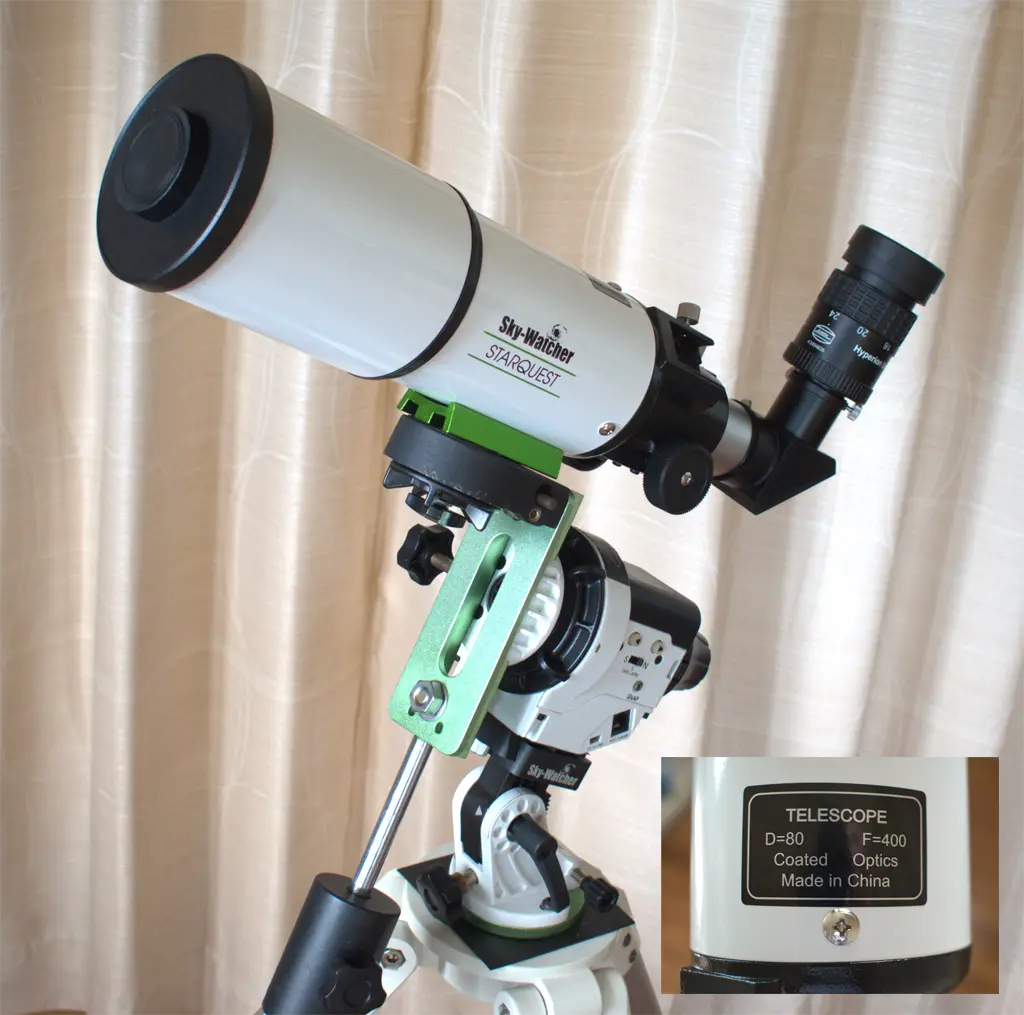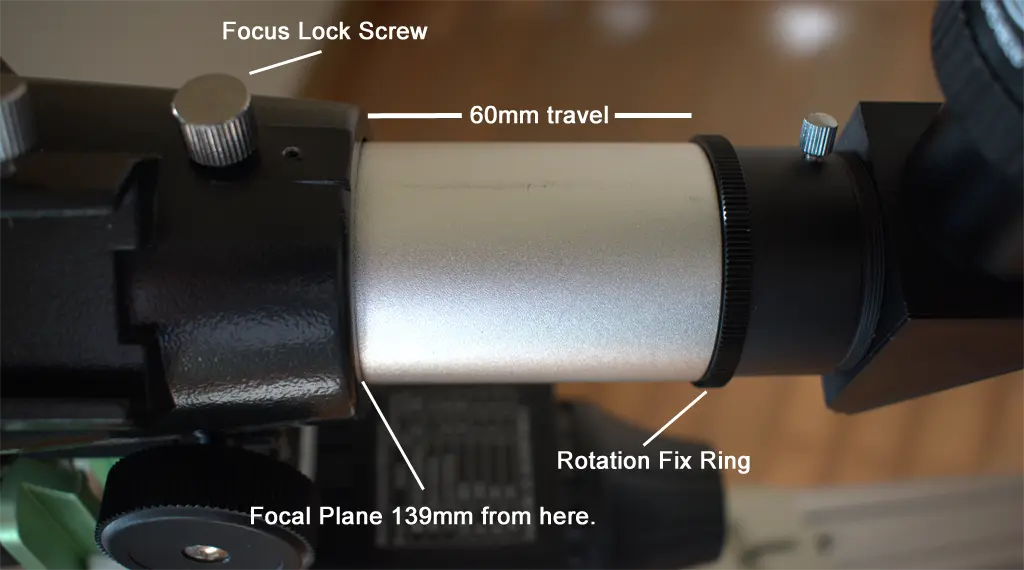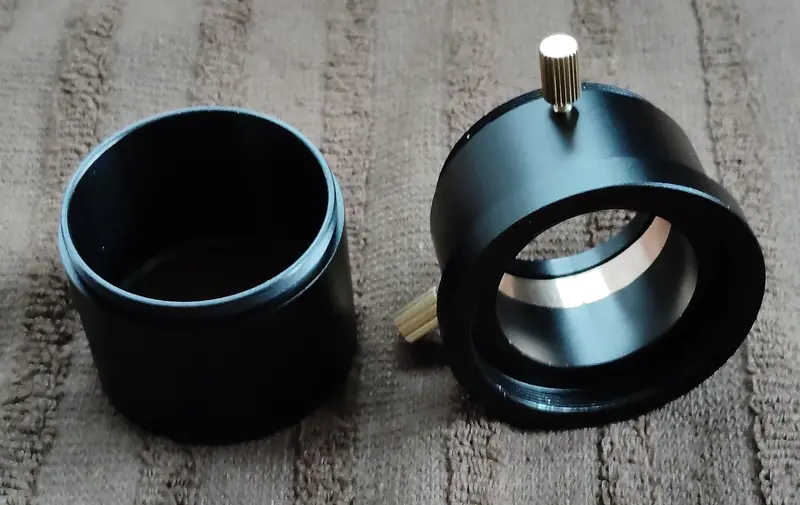Equipment Review (preliminary)
Sky-Watcher Starquest 80
Purchase price: 17,600 JPY
Dealer: KYOEI-TOKYO
Conclusion: A fine achromatic lens and robust focuser
Please appreciate that this review reflects personal impressions and views.
The Sky-Watcher brand is owned by Synta Technology Corporation. The Starquest 80 is no longer in production (discontinued).

General Impression
Advertised as beginner's telescope this short-tube OTA surprises with fine optical quality given it is a simple achromatic (optically imperfect) design. With its Ø80mm aperture and 400mm focal length it is a standard f/5 design aiming at observation of star clusters, galaxies and nebulae. Its focal length is too short for planets, but the small moon looks pretty through a quality eyepiece.
According to the manufacturer, the Starquest 80 has "Coated Optics", in that we do not know whether it is single side coated or, more likely, multi-coated.
Attached to the OTA is a 80mm Vixen-style dovetail plate which is okay for visual use on a tripod or mobile tracker but insufficient for balancing with an attached camera (well it is not an astrograph). The dovetail has two 1/4 inch threads for mounting on a tripod.
Mounted inside the OTA is a baffle ring playing a crucial role in reducing stray light by blocking unwanted light paths, minimizing internal reflections and improve contrast.
The barrel is made of metal, yet keeping the telescope lightweight (1.3kg) and portable. Its sturdy construction helps maintain optical alignment. Only the lens cell is made of plastic.
Chromatic aberration (color bleeding) cannot be overlooked, in particular and naturally at higher magnifications on bright objects, but it is actually little for an f/5 achromat providing decent color correction for its price range.
Focuser and Accessory Interface
The focuser is surprisingly smooth and rigid, a real bonus. It travels 60mm and can be fixed with a screw without tilting the draw tube. The back focus plane lies 139mm away from the rear of the barrel, explaining the short tube of 355mm including the length of the non-expandable, non-retractable dew shield. Therefore, a long extension tube (Ø42mm, L=80mm min) is required for a dedicated astrocam, while the focuser travel is just long enough for a DSLR reaching infinity focus without extension (the sturdy focuser comes in handy here). Extension is required even when using 0.75x and 0.5x reducers threaded on an astrocam.
The accessory mouth takes a 1.25" star diagonal (bundled) eyepieces is M42/0.75mm (male) threaded for a CMOS astrocam or a T-ring for a DSLR. A so attached camera can be rotated with a fix (mounting) ring located between the focuser and the accessory holder. It is a bit primitive, cost-saving solution but working well.
When using cameras, please bear in mind that, in general, long extensions and a widely rolled out focuser can cause tilt in the optical axis.
Focuser Travel for Reference
The idea is to use various magnifiers on the nose piece of an astrocam or an eyepiece without need for swapping extension tubes to reach focus. This is merely a guideline as flange back of cameras and position of focal planes in eyepieces vary. The final reduction or magnification factors depend on the distance of the reducer or barlow lens to the focal plane. Also, focuser mileage can vary with the type of the reducer or barlow, in that is hard to predict the effective focal length. In this example, the optical path of the extension is 65mm while the astrocam, Player One's Neptune-M, has a flange back of 12.5mm. The test eyepiece is a Baader 8-24mm zoom locked at 24mm. The focuser travel for each configuration is given in millimeters:
| Magnification | Astrocam | 24mm Eyepiece | Note |
|---|---|---|---|
| 0.5x reducer | 5mm | 28mm | GSO |
| 0.75x reducer | 20mm | 35mm | Sightron |
| 1x without | 31mm | 42mm | n/a |
| 2x barlow | 40mm | 44mm | Takahashi Ortho 2-element |
| 2x barlow | 50mm | 56mm | ditto, without tube |
| 2x barlow | 38mm | 40mm | Vixen 3-element |
| 3x barlow | 40mm | 42mm | Kokusai Kohki Photon 4-element |
With an extension of 65mm you can use various magnifications without need for threading and re-threading extension tubes for reaching focus. Remember, the focuser is highly rigid. Also tested with fixed focal length eyepieces, 6mm, 12mm and 25mm. They all get into focus.
Optical Path of a Refractor

Source: Celestron LLC
Included Eyepieces
The achromatic design balances cost and performance, making it a good entry-level telescope. However, at f/5, it’s considered a "fast" telescope, which can be less forgiving with lower-quality eyepieces, potentially showing optical aberrations like coma or astigmatism at the edges of the field of view with certain eyepieces.
The bundled 25mm and 10mm eyepieces are probably uncoated Kellner or Modified Achromat designs in plastic tubes, based on Sky-Watcher's typical offerings for entry-level telescopes. These eyepieces provide magnifications of 16x and 40x, respectively, and may show limitations in a fast f/5 system due to their simpler optical design. Kellner eyepieces might not be the best choice for telescopes with fast focal ratios (f/5 or faster) due to potential optical aberrations. For better performance, especially at the edges of the field, upgrading to Plössls or wide-angle eyepieces could enhance the viewing experience. To keep parts count low, a zoom eyepiece such as a common 8 mm (50x) to 24 mm (17x) will be fine, too.
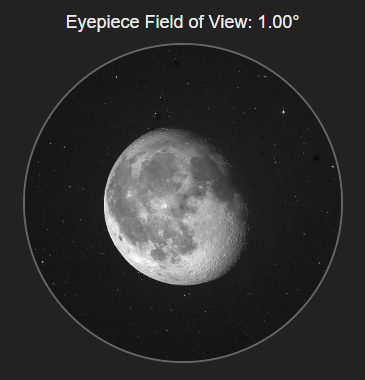 Simulated view with the bundled 10mm eyepiece
Simulated view with the bundled 10mm eyepiece
Terrestrial Use
The Starquest 80 is also a fine scope for terrestrial observations, however, the included 90° star diagonal mirrors the view in that users may wish to replace it with a "45° Erect Image Diagonal" which delivers right side up and left-to-right correct images as if you're looking through binoculars when used with refractors for daytime terrestrial viewing. A reduction in the quality of an optical image (astronomical or terrestrial) is always associated with additional optics (mirrors and lenses), but quality parts will hardly introduce discernible issues.
Sample DSLR Image
 The buildings appear blurred as they are located at different distances which would need to be refocused on. Nikon D5500 + 42mm T-ring, 1/4000 sec at ISO100. Click to enlarge (10MB).
The buildings appear blurred as they are located at different distances which would need to be refocused on. Nikon D5500 + 42mm T-ring, 1/4000 sec at ISO100. Click to enlarge (10MB).
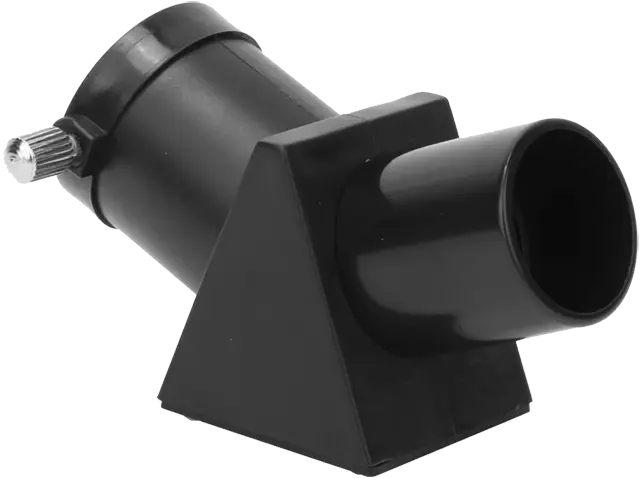
About Chromatic Aberration
An achromatic telescope is typically made of two air-spaced or cemented lenses, usually a positive low-index (crown) element and a negative high-index (flint) element, to reduce chromatic aberration (color bleeding) and improve image clarity, helping to correct color distortion while keeping the telescope affordable. Chromatic aberration is distortion that occurs when white light is refracted into different color wavelengths therefore not focusing on the same plane. To some extend chromatic aberration can be oppressed with narrow band filters, such as dual-band or quad-band, but a good filter costs around as much as this telescope. It is rather subjective, some people tolerate CA while others find it egregious. After all, there is no perfect lens.
Another type is "comatic aberration" which occurs when an object that lies off the optical axis appears in an egg-shaped or V-shaped, comet-like flare. Even corrected doublet and triplet apochromatic quality refractors will need optional "flattener" lenses for round stars in the corners of DSLR fields. Smaller camera sensors may not interface with the critical zone.
Optical performance test results with images to be delivered after the Rainy Season in Japan.
We will also experiment with the Starquest 80 as guidescope on an 8-inch FL=2030mm SCT (with flexure issues and a narrow FOV on mind), with and without reducers.
Specification Overview - Starquest 80
| Optics | achromatic refractor |
| Objective | two air-spaced lenses, multi-coated in plastic cell |
| Aperture | 80mm |
| Focal length | 400mm |
| Focal ratio | f/5 |
| Resolving power | 1.44" |
| Limiting magnitude | 11.3 |
| Light gathering power | 131x |
| Focuser type | rack & pinion |
| Focuser travel | 60mm with lock |
| Focuser thread | M42/0.75mm |
| Eyepiece sleeve | 1.25" |
| Back focus | 139mm |
| Tube material | metal |
| Tube length | 355mm |
| Tube weight | 1.3kg net |
| Warranty | 1 year |
| Included accessories |
|
| Recommended optional accessories |
|
Pros
- Smooth and rigid R&P focuser (excellent!)
- Generous 60mm focus travel
- Large Ø40mm focuser knobs
- Acceptable chromatic aberration
- Low OTA weight
- Attractive cost-performance ratio
Cons
- Focuser gear ratio a bit coarse for f/5.
- 80mm dovetail length is too short for balancing photographic gear.
- Finder base not precision machined, pointed fixing screw leaves scratches.
- Bundled eyepieces do not give justice to the fine objective lens.
Conclusion
Though not specifically designed for imaging, this achromat features a quality lens, delivering sharp and contrast-rich terrestrial views. Due to its simple — though inherently imperfect — optical design, the outer regions of the field of view exhibit green and violet fringing in the eyepiece. The bright moon and planets are framed by violet bleeding. However, a wide central circle remains nearly free of chromatic aberration. As a result, deepsky imaging is feasible with small sensors like the IMX585, IMX676, or IMX678, which capture only the central portion of the view. Additionally, narrow-band filters can help mitigate chromatic aberration. This achromat is an affordable, regret-free choice for novices in both visual observation and imaging. Its balance of quality and price makes it an appealing introduction to a hobby where everything can go wrong at once—but ultimately offers a motivating reward at the end of the day.
